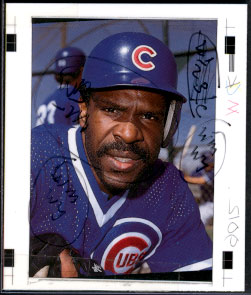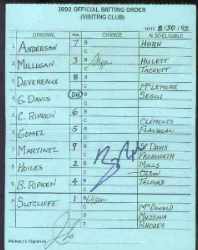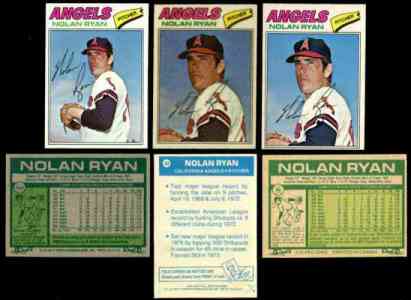1991 Topps Box Bottom MATCH PRINT PHOTO - ANDRE DAWSON
RARE ONE-OF-A-KIND item from Topps Legendary Vault with their COA !!! (Cubs)
| Grade |
NM/MINT to EX/MINT |
| Book Value |
n/a |
| Our Price |
$ 49.95
Add to cart
|


Below are short bits & pieces on sportscard & baseball trading card collecting.
Please wander around the website for more info, prices, values & images
on vintage baseball, football, basketball, hockey, sport and non-sports cards.
Vintage Boxing cards
Checklist & Values
Like baseball cards, boxing cards have been produced in this country
since the 1880's. First in tobacco products, later in gum and candy.
Unlike baseball cards, boxing cards have been produced in many countries
around the world.
In 1910 Mecca and Hassan tobacco companies put out colorful boxing sets
with names like: Jack Johnson, Jim Jeffries, John L. Sullivan & Jim Corbett.
In 1951 Topps joined in with a fairly large card set they called "Ringside".
|

Authentic Major League SIGNED
Game-Used LINEUP Cards (PSA)

These are the official lineup cards SIGNED BY THE MANAGER & given
to the home plate umpire before the game with the team's line-up
& batting order !!! Making them even neater, often managers made
lineup changes on these cards throughout the game.
These official lineup cards were SIGNED BY THE MANAGER and presented
to the home plate umpire before the game. They detailed the team's lineup and
batting order. Managers often made lineup changes on these cards throughout
the game, making them even more unique.
Collectors say "They are official documents of a particular game, so they are
absolutely historically relevant. The manager, he was the general in the war.
Imagine owning Eisenhower's list of who he wanted to go into battle, and then he
signed it !!! Imagine what that would be worth?"
The first dugout lineup cards were seen around 1960. Along with lineup
cards, most ended up in the trash after games, making them quite rare today.
MLB saw the light and started marketing them directly in the 2000's.
Astronomical prices have been paid for cards from special games.
$165,010 for the Red Sox dugout lineup card from Game 4 of the 2004 World Series.
$138,000 in 2007 for 1st ever All-Star Game batting order cards.
$ 40,000 for batting order cards and the pen used to fill them out from
Cal Ripken's 2,130th & 2,131st games.
Click for complete
Major League SIGNED Game-Used LINEUP cards
Note: You may be on that page right now.
|

|
1977 Topps Cloth Stickers
Checklist & Values
As 1977 baseball season was winding down, Topps wanted to sell more cards
and released the "1977 Topps Cloth Stickers" test issue.
The 1977 Topps Cloth Stickers set came in at (73) total cards: (55)
cloth stickers and (18) checklist/puzzle cards that
formed large photos of the 1976 AL & NL All-Star teams.

2 Stickers and 1 checklist/puzzle card were in each .15 cent pack
with 36/packs in a box.
Nearly all fronts are same as the regular issue
- with a few different like Nolan Ryan.
LEFT: Regular issue;
CENTER: Cloth Sticker;
RIGHT: O-Pee-Chee (from Canada).

The 2-1/2" x 3" stickers had highlights & instructions on back.
The backing was easily removed and kids could stick them everywhere !
TEACHERS LOVED THEM !!!
Packed with Hall-of-Famers (19 of 55) plus Pete Rose and Mark Fidrych.
In addition, stickers & puzzle pieces came with one '*' or two '**'
asterisks on back.
|

Baseball card collecting terms (part G)
Grade/Condition Centering, corner wear, photo clarity, edges,
creases, print flaws ... all combine to determine a card's condition or grade.
Along with rarity/scarcity it is the major factor in a card's value.
Graded Card As values increased the condition of cards and the
determination of fakes and alterations became increasingly more important.
Various companies became "graders" of your cards. For a fee they would grade
your card (usually on a 1 to 10 scale) and then placed in a sealed plastic
holder with labelling of the vital information.
From past experiences, most people are NOT HAPPY with the grades they receive.
To keep values up, graders can be extremely picky. Things you don't see,
they do so don't be surprized when the NEAR MINT card you send in ends up
with an EX or EX/MINT grade.
There are TOO many grading companies - if you do, do choose carefully.
PSA / SGC / GAI / BGS are some of the many companies.
It is good to know that getting a card graded by a company that people
do not recognize or respect will usually just cost you time and money
and not help you in any way.





 These are the official lineup cards SIGNED BY THE MANAGER & given
to the home plate umpire before the game with the team's line-up
& batting order !!! Making them even neater, often managers made
lineup changes on these cards throughout the game.
These official lineup cards were SIGNED BY THE MANAGER and presented
to the home plate umpire before the game. They detailed the team's lineup and
batting order. Managers often made lineup changes on these cards throughout
the game, making them even more unique.
These are the official lineup cards SIGNED BY THE MANAGER & given
to the home plate umpire before the game with the team's line-up
& batting order !!! Making them even neater, often managers made
lineup changes on these cards throughout the game.
These official lineup cards were SIGNED BY THE MANAGER and presented
to the home plate umpire before the game. They detailed the team's lineup and
batting order. Managers often made lineup changes on these cards throughout
the game, making them even more unique.


